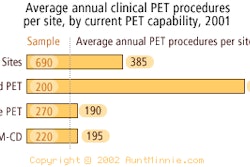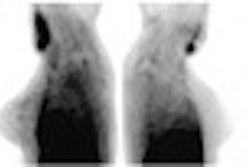Less than six months after raising Medicare reimbursement rates for FDG-PET procedures, the Centers for Medicare and Medicaid Services (CMS) has recommended significantly lower rates for 2003, sparking a flurry of activity among PET proponents to educate CMS on the true cost of PET.
In March, CMS settled on final 2002 PET reimbursement rates for hospital outpatient facilities under the agency’s Hospital Outpatient Prospective Payment System (HOPPS), which went into effect in 2000. On August 9, the agency published a preliminary rule in the Federal Register that boosts payment rates to hospitals for outpatient services 3.5% overall in 2003, but decreases PET reimbursement levels. Nonhospital outpatient imaging centers would not be affected.
If finalized, the rule will move PET out of its new-technology ambulatory patient classification (APC), and will set payments for cardiac procedures at $870.11 and for tumor procedures at $971.53 (CPT codes G0030-G0047). The 2002 rates for these procedures were $958.52 and $1,375, respectively. An FDG dose of 4-40 mCi/ml (CPT code C1775) is scheduled for reimbursement at $475.
In the meantime, industry groups such as the Academy of Molecular Imaging (AMI) and the Society of Nuclear Medicine (SNM) are preparing written responses to the agency in the hope that the rates will remain stable.
In a September 24 letter to CMS, representatives from the SNM, the National Coalition for Quality Diagnostic and Imaging Services (NCQDIS), and the National Electrical Manufacturers Association (NEMA) urged the agency to keep FDG-PET in the new-technology category for another year in the hope that correct cost data could be collected, and more accurate reimbursement levels determined.
According to William Uffelman, general counsel and director of public affairs for the SNM, data from hospitals that CMS used to set the proposed rates are based on flawed 2001 figures that do not reflect the cost of dedicated PET.
Gamma camera use for PET imaging was high in 2001, Uffelman said, and gamma camera costs are much lower than dedicated PET costs. Also in 2001, hospitals had no way of distinguishing between gamma camera and dedicated PET procedures on their claims. CPT codes that differentiate gamma camera versus dedicated PET did not come into effect until January of this year, which was after the reporting period for claims data.
"In 2001, CMS used old data that pre-dated the current billing system (to set reimbursement rates), and in 2002, it only had half a year’s accurate data on dedicated PET," Uffelman said. "Now there are separate codes for procedures. In another year, cost data would be based on pure full-ring PET (numbers), and would therefore be more accurate."
Hospitals need more time to learn these new codes and how to report PET procedures, according to Monroe Meyerson, a member of the Academy of Molecular Imaging’s industry committee and chairman of Radiology Corporation of America, a provider of mobile and fixed-site PET imaging services in Boca Raton, FL.
"PET is such a new technology, users are still getting a handle on it, which is why it’s important that it remain in the new-technology category for billing," he said.
Not only are the numbers used to set reimbursement rates flawed, but they don’t take into account how much it costs to use and maintain a dedicated PET camera, which can carry a list price of more than $1 million, according to Uffelman.
"PET cameras are in the $1.8 million range, and depreciate by about $30,000 per month," he said. "Is $1,300 a good rate? It’s a rate. Is $900 a good rate? It’s bankruptcy."
If the proposed 2003 rate becomes final rule, it will affect both patient care and the PET market. PET proponents are hopeful that CMS will respond to comments and adjust its reimbursement rates, said Ruth Tesar, executive director of Northern California PET Imaging Center in Sacramento.
"Hospital outpatient PET imaging will definitely be hit if these rates go through," she said. "And we’re hoping to prevent that. There are two components to success in the payment arena: coverage and payment level. We’ve worked to get PET covered. Now it needs to continue to be covered at a reasonable rate to sustain the market."
CMS is accepting comments through October 7. Written responses (1 original and 2 copies) should be sent to the Centers for Medicare and Medicaid Services, Department of Health and Human Services, Attention: CMS-1206-P, PO Box 8018, Baltimore, MD, 21244-8018.
By Kate Madden YeeAuntMinnie.com contributing writer
September 30, 2002
Related articles
U.S. Senate leaders reach deal on Medicare provider payment changes, September 27, 2002
Decrease proposed for 2003 PET APC reimbursement, August 12, 2002
Hospitals say Medicare rate hike falls short, May 10, 2002
New HOPPS rates bring PET reimbursement hike, March 4, 2002
Copyright © 2002 AuntMinnie.com



















